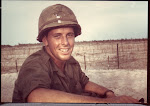KANDAHAR, AFGHANISTAN: Midway during the war in Viet Nam war, Tan Son Nhut airport on the outskirts of Saigon was the busiest in the world. Aircraft of every description covered the ramp along with most of the field that wasn’t runway. With the recent addition of 30,000 US troops to Afghanistan, along with their civilian support personnel, KAF (Kandahar Air Field) may be fast approaching that title. To date it is the busiest, single runway airport in the world.
“They’re even sprucing up the old civilian terminal for the upcoming Hajj, the annual Moslem pilgrimage to Mecca and Medina” said US Air Force Captain Joe Bauer. Capt. Bauer is a finance officer whose responsibility is training his counterpart in the developing Afghan Air Force (AFF). This morning he is guiding journalists who are waiting for transport to their embed locations on a tour of the facility. Capt. Bauer is assigned to the 38th Air Expeditionary Advisory Force which has the responsibility of training the Afghan Air Force.

Kandahar Air Field with Russian MI 17 helicopter in the foreground and a Russian freight plane taxing in the background.
New buildings are sprouting up along the flight line as well as nearly every vacant lot on this sprawling base. A recently completed steel hangar houses the fleet of six Russian built MI-17 helicopters, one of which is being torn apart for a hundred hour inspection. Another is on the ramp for training purposes while the remainder out on re-supply missions in the countryside. These tough all purpose machines are likened to an old Ford truck; very tough, and simple to operate and repair.
This area of KAF is to be the new headquarters of the Afghan Air Force. “We have $60 million worth of construction underway and intend to spend $180 million overall,” said Capt. Bauer. “This Afghan force is being built from scratch”, continued Captain Bauer. “Their Deputy Base Commander happens to have great credentials. He was a Mig 21 pilot and had trained as a cosmonaut years ago with the Russians, but he stands alone.”
As well as being an airport and military air base Kandahar Air Field is also the home of various US Army units as well as a mix of forces from other NATO countries. Canadian and Dutch forces have a great presence here however both are expected to be leaving in the near future. Presently the civilian and military population is in the neighborhood of 25,000. The geographic area has at least doubled in the last two years. If and when the US leaves this will be an enormous physical complex for the Afghans to manage.
Afghan pilot recruits at the main hangar on Kandahar Air Field.
Nearly two dozen print and video journalists have been waiting at the RC South Media Support Center for transport to their embed sites and are not interested in touring the base. Many live in Kabul full time. Nearly all of these reporters are to be assigned to Task Force Raider, a joint Afghan Army – NATO force operation in Helmand province about which not much is known. The word among journalists permanently based in Afghanistan is that news media are not wanted there yet because things may not be going as well as current official reports indicate.
Their feeling is that military authorities would prefer that media remain in the rear for the time being. Operation Dragon Strike which is being fought primarily in the Arghandab river valley in Kandahar province by US Army forces, US Special Forces and Military Police as well the Afghanistan Army soldiers. Various reporters covered the Battle for Marjah last February. Their published reports did not jive with the story put out by military publicists hence the military’s hesitancy inviting them in this early in an operation that has its own problems.
*A version of this article was published by the Press Republican on November 16, 2010.


No comments:
Post a Comment